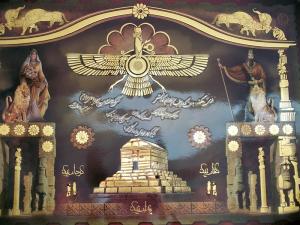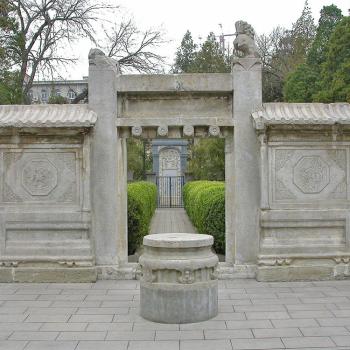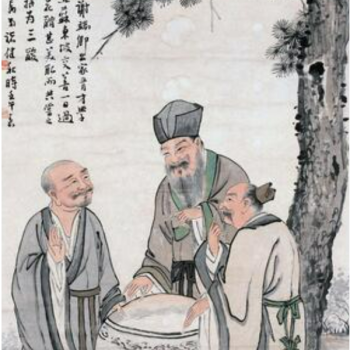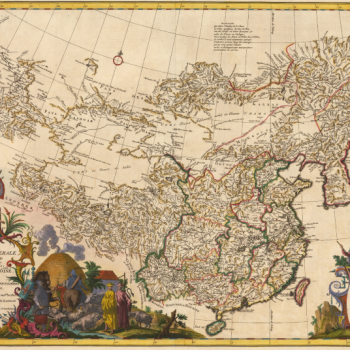To properly understand Christianity as an eschatological faith, it behooves us to understand the deep apocalyptic roots of the ideas which define it. Central to the Christian religion is the age-old concept of the messiah, the divinely-appointed savior who will redeem God’s chosen people in the final days. As noted last week, all the major world religions have at some point hit upon the idea of something like a messiah. The idea of a single world-transforming hero appears to hold a fundamental appeal for humanity, and thus it has been reproduced countless times in countless faiths and mythic accounts, from Maitreya to the Mahdi to King Arthur. But the messiah concept proper comes to Christianity through a direct line of transmission that stretches back centuries before the life of Jesus of Nazareth.
How far back in time that line extends will probably always be a matter of debate. But many scholars argue that the messiah concept that later blossomed in Christianity has its first roots in ancient Persia, in the teachings of Zoroastrianism. Zoroastrianism is either the world’s first or second major monotheistic faith (depending on where in time one positions the prophet Zoroaster relative to Akhenaten, the monotheistic pharaoh of Egypt) and the first to achieve widespread adherence. It seems to have begun as a reform movement of the older Iranian polytheistic religion—itself a spin-off of an Indo-Iranian faith that in turn descended from the enigmatic proto-Indo-European religion—but quickly took on a life of its own. Though today in rapid decline, with only a few thousand practitioners left globally, Zoroastrianism was, for over a millennium, the dominant faith of the Near East.

Zoroastrianism sees the world as existing in a state of constant struggle between good and evil. On one side is Ahura Mazda or Ohrmazd, the Zoroastrian conception of God, who is the creator of the material world and all that is good. On the other is an entity called variously Angra Mainyu or Ahriman, who is the creator of all that is illusionary and evil, and the perverter of Ahura Mazda’s wholly beneficent design for creation. Aside from his inauguration of monotheism, Zoroaster’s greatest stroke of genius was to define reality in these staunchly moral terms. Gone were the deities who personified natural forces and generally behaved according to their own amoral interests. Good and evil were now the primary constituents of both the physical and the spiritual world. The ethical life of the believer now became the central concern of faith. It was a remarkable paradigm shift in religious thought, one which we still very much find ourselves in today.
But this moral reorientation of the cosmos in turn required other reorientations. One was in the personal fates of those who had chosen good and evil lives. As the Encyclopædia Iranica entry for him states, “Although it is impossible to know whether or not it was his innovation, Zaraθuštra [Zoroaster] was the first in recorded human history to articulate a clear theology of a heaven for the righteous and a hell for the wicked” (“Zoroaster”). However, Zoroastrianism was far more than simply a personal faith. The battle with Ahriman is universal and involves everyone. For it is the role of every believer to continually choose good over evil, both individually and collectively, in order to tip the balance more and more in Ahura Mazda’s favor. Zoroastrianism is thus a communal faith in the fullest sense of the term, uniting the whole community of believers in a universal struggle against cosmic evil.
But by proposing that the individual life, the life of the community, and that of the whole world are to be premised on helping good prosper in this cosmic struggle, Zoroastrianism necessarily invites questions about how the struggle itself will end. Thus, while the Encyclopædia Iranica observes that, “What is not explicit is whether, beyond individual eschatology, Zaraθuštra had a theology of world history that would terminate with the establishment of a paradisical state” (W. W. Malandra, “Zoroaster”), the Zoroastrian faith soon found itself in need of just such a theology, one which could promise the eventual triumph of good and the remaking of the world. Thus, an elaborate eschatology arose, in which, “[t]he disturbance caused in the cosmic order by Ahriman’s invasion of a domain out of his own is permanently and utterly removed, and the world made to change into a new mode of existence where no evil can interfere” (Malandra, “Zoroaster”). Zoroastrian eschatology promises that someday, Ahura Mazda will finally and irrevocably defeat Ahriman, drive evil from the cosmos, and remake the world according to His original, perfect design. The resulting world will be a paradise of the righteous that Ahura Mazda will rule over benevolently forever and ever.
There are many elements to the Zoroastrian end-times narrative which are immediately recognizable from their recurrence in Judaism and especially Christianity. There is the final battle with the forces of cosmic evil. There is a general resurrection of the dead and a final judgment of the righteous and the unrighteous. And there is the Frasho.kereti or Frashegird, a reshaping of the world in a perfectly even paradise where God and His attendants dwell directly amongst humanity, recalling at once both the millennial kingdom and the New Jerusalem of later Christian eschatology. But, most importantly for our purposes, these great events are all brought about through the intervention of a messianic savior, the Saoshyant, born of a virgin mother impregnated with the seed of Zoroaster at the end of time.
To the Saoshyant, whose personal name is Astvat.ereta, is given the task of leading the Zoroastrian community, driving evil from the world in the final battle, granting immortality to humanity, and inaugurating the world’s renovation. Thus, in the Saoshyant, we see many echoes of later Judeo-Christian conceptions of the messiah. Like the Jewish messiah, he is fully human, but is marked out by his special lineage—in this case from the founding prophet Zoroaster rather than the founding monarch David. Like Christ, he plays a special role in ringing in cosmic renovation and making humanity immortal. Indeed, as Jenny Rose notes in Zoroastrianism: A Guide for the Perplexed, the “revitalis[ing] of the world through making corporal existence indestructible” (Rose 50) seems to have been the defining feature of this savior from his earliest appearances. In the Saoshyant, then, we have either a convincing prototype of the Judeo-Christian messiah or at the very least a foreshadowing of all the hopes and expectations which that later figure would come to embody.
But the Saoshyant is more than a wish-fulfillment fantasy. In many ways, he represents the logical outgrowth and conclusion of many trends in Zoroastrian thought. One was, as noted above, the emphasis placed on the struggle of good and evil, which necessarily required an outcome. But the Saoshyant is also necessitated by the unique way in which Zoroastrians view their role in God’s plan. While the Abrahamic faiths tend to emphasize the overarching authority of God to shape the course of events as He wills, Zoroastrianism insists that God needs the active participation of humanity to achieve victory over evil and the transformation of the world. All human beings thus play a crucial part in either furthering or frustrating the world-saving work of God. This creates a sense of all humans throughout time as constituent parts of a single community whose actions, both individually and collectively, ultimately determine the fate of the world.
This sense of humanity as a single, united community is strong within Zoroastrian thought, even if it was never much of a focus for the various Zoroastrian polities of antiquity (though the same, of course, could be said for the various Christian states in later times). It can be seen in the universalism of various Zoroastrian apocalypses, which assert that hell is only temporary and that, once purified of their sins, evildoers will be able to join the rest of humanity in the world to come. But it is also seen in the figure of the Saoshyant. As Rose observes, “Zoroastrians look to the example of Zarathustra in the past and toward the saoshyants who will come in the future, and consider how they are positioned to bring benefit in the here and now” (Rose 137). Zoroaster and the Saoshyant form the ends of a continuum in which all believers find their place. Rather than being a distant figure who swoops in and saves everyone from without, the Saoshyant is the culmination of a saving process that started with Zoroastrianism itself and includes everyone. That he is the (very, very posthumous) son of Zoroaster rather than the returned prophet himself emphasizes this sense of continuity and collective progression across historical time, as does the commonly encountered notion that Astvat.ereta is in fact the last of three saoshyants, with two previous saviors being required at different epochs to prepare the way for him. The messiah is certainly of central importance to Zoroastrian apocalyptic and yet the story of the end is never just the story of a single man.
What it is instead is a profoundly hopeful vision of the future which gives impetus to useful moral action in the present. What becomes clear from the Zoroastrian apocalyptic tradition is that it does not run along the lines which pop-culture and modern religion has conditioned us to expect. There is no pessimism, no throwing up of hands at the state of the world’s decay. There is no running away from a degenerate society and no passively waiting for God to intervene from without and tie things up for us. There is no rapture and no safe perch for the righteous while the rest of the world quite literally goes to hell. Certainly, as we close in on fifteen hundred years from their faith’s eclipse, Zoroastrians have had ample opportunity to indulge in these sentiments from time to time, and many likely have. But this is against the grain of Zoroastrian eschatological discourse. Zoroastrian apocalyptic is not an excuse to hide from the world but a call to actively engage with the world in a moral and productive manner. The believer cannot stand by and let the world deteriorate; they must work unceasingly to make it better. The glories of a cosmos redeemed from evil can only come about if humanity is actively and beneficently present in the world of today.
It is a powerful eschatological vision. It provides a basis for optimism and action in a very damaged world and encourages a love of all humanity despite their many faults and moral failures. This is what distinguishes Zoroastrian thought from the fearmongering of so much modern apocalypticism, from doomsday cults to evangelical circles. This hopeful, communal, and universal focus no doubt accounts for the religion’s great success in antiquity and, I hope to make clear over the coming weeks, is the necessary precondition for any form of eschatological thought to have a widespread, lasting, and positive impact on society. Of course, it may seem strange to cite Zoroastrianism as the first model of such an impactful system, given that the faith’s modern numbers are miniscule and most people have never even heard of it. But such a citation is more than justified not only by Zoroastrianism’s ancient reach but also by the significant influence which is had on the three Abrahamic faiths which came after it and which still dominate the world today.
Scholars over the years have attributed various central tenets of Judaism, Christianity, and Islam to Zoroastrian influence, from a belief in angels and demons to a preoccupation with good and evil to the very concept of monotheism itself. Such suggestions have met with various levels of support over the years and the contributions of Zoroastrianism in these regards are still debated. But the case for Zoroastrian influence over the development of Judeo-Christian eschatology is particularly strong. It was only in the post-Exilic period, after the Jewish people had returned to their homeland at the behest of a Persian king who was likely a Zoroastrian, that a proper Jewish eschatology begins to form for the first time.
Exile had taken the Jewish people into cosmopolitan centers of Iraq and Syria, where Zoroastrianism was prevalent, and it is after this prolonged period of contact that ideas such as the general resurrection, the final reward for good and evil, and, above all, the future world-savior first make their appearance in Judaism. The word “paradise”—so tied into the Abrahamic faith’s understandings of the beginning and the end—is ultimately of Persian derivation. The first person ever to be termed a “messiah” in the Bible was Cyrus the Great, the above-mentioned Persian who allowed the return of the Jewish people to Israel. The demon Asmodeus, who appears in the Book of Tobit (a Jewish text included in the Catholic canon), is a character directly borrowed from the lists of Ahriman’s lieutenants, making it all the more likely that Satan’s transformation from the “loyal opposition” of Job to the enemy of all creation in apocalyptic Judaism and Christianity is itself inspired by Ahriman’s role in the Zoroastrian faith. And of course, when Christ is born in the Gospel of Matthew, it is the magi—Persian Zoroastrian priests—who recognize him as the long-foretold savior and attend to his birth. Ultimately, the shadow which Zoroastrian eschatology casts over Biblical apocalyptic thought is quite long and extends to the present day.
Which is not to say that all that is to be found in the apocalyptic narratives of Judaism, Christianity, and Islam has a Zoroastrian basis. The Abrahamic apocalypses respond to their own times and sets of concerns in a manner which is often quite different from Zoroastrianism. But the basic ingredients, and a framework for how they all fit together, are there in the Zoroastrian texts. The web of concepts which Zoroastrianism likely gifted to the Abrahamic faiths were crucial to creating the climate of apocalyptic expectation which permeated Second Temple Judaism. It was, of course, out of these conditions and this particular web of concepts that Christianity arose, spread, and ultimately came to thrive. Furthermore, as I will emphasize in the coming weeks, the same communal basis and hope for the transformation of society as a whole that so characterized Zoroastrianism also infused early Christianity and was the decisive element which allowed Christianity to rise from a marginalized faith to the religion of the western world. At a time when Christianity itself faces the prospect of its own decline and the hopeful dimension of eschatology is nowhere to be seen, it might do Christians well to remember the Zoroastrian example.
Works Cited
Malanda, W. W. “Zoroaster ii. General Survey.” Encyclopædia Iranica, 2009. ZOROASTER ii. GENERAL SURVEY – Encyclopaedia Iranica (iranicaonline.org)
Rose, Jenny. Zoroastrianism: A Guide for the Perplexed. Bloomsbury, 2011.











